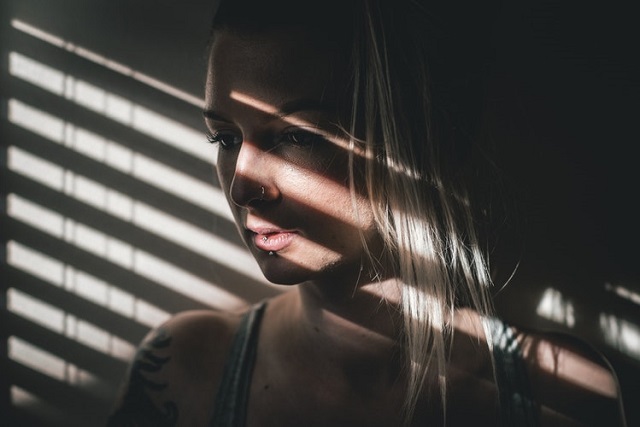
Feeling the wisp of a cool breeze on a summer’s day, basking in the sunshine, reveling in a soothing, serene sunset walk on the beach—that’s the pleasant stuff, the beautiful stuff, the stuff of love songs, poetry, sonnets, and unrestrained proclamations of hope, and love, and all is right, and life is good.
But, that’s not the good stuff, the substantial stuff, the earth-shattering, world-changing, life-altering, soul-penetrating stuff.
The hearty stuff, the meaningful stuff, the stuff that radically changes our very experience of the world—that stuff comes from witnessing our darkness, everything we’d rather not admit to or acknowledge.
It’s piercing through the darkest shadows, looking directly into the black mess of muck and chaos.
It’s in not only seeing a black hole, but opening that sucker right up—reaching in and grabbing whatever unknown demons lurk inside.
Through mindfulness, we become aware of thoughts we’re not proud of, tendencies that don’t serve us, and entire belief systems that are based on false ideas we’ve unwittingly groomed.
My ego, I’ve learned, is far more limiting than self-promoting—more concerned with breaking me down than building me up. She’s on a quest, it seems, to keep me stagnant and safely secured behind a shroud of self-doubt.
I know her voice. I’ve become intimately familiar with her tone and her tendencies, her bent toward making me feel worthless, inadequate, undeserving, incapable, and utterly inferior. She questions every action and potential decision.
I’ve grown accustomed to her seemingly unceasing, incessant chatter. I know when to expect her rebuke—the precise moments when she’s likely to wreak havoc.
I’ve also had to learn how to work through her admonishments, how to allow her condemnations the space to exist without internalizing them, and how to simply watch all of the vitriol without allowing it to overtake me. And then, despite the discomfort swirling inside of me, how to gently force myself to consciously move through it.
Mindfulness can be blissful and serene—but often, it’s disconcerting and unsettling.
It is being willing to be present with whatever crap comes up—and a lot of it, if we practice long enough, is crap. It is discovering the worst parts of ourselves and trying to witness them without judgment.
It’s hearing everything, watching everything, and feeling everything.
The problem is that most of us don’t realize what’s happening. We simply acquiesce to the voice that says we’re not good enough.
We allow ourselves to become immobilized, because we are unwilling (or unable) to see beneath the filth—barely able to sneak furtive glances toward all it is we want to do, or be, or have.
Through mindfulness, we come to understand that we view the world through the stories we tell ourselves, tales of who we are, what we can have, what we should want, what we deserve, and who we believe the people around us expect us to be. Internalized, self-perpetuating ideas of whatever limiting beliefs we’ve accumulated define the way we live our lives.
While it is uncomfortable to consciously move through our pain and insecurities, the only way to work through them is by accepting their existence.
We can’t change something until we realize it’s happening. And to fully feel the impact of it, especially when it comes to our thoughts and beliefs, we have to let ourselves feel them.
It takes committed, diligent practice to stay in a space of awareness, especially when what we’re observing doesn’t make us feel particularly good.
To do this, we have to do so with patience, compassion, tenderness, and an understanding that it will take time to reverse ideas we’ve spent years (or even decades) unknowingly curating.
The beauty of mindfulness isn’t just in experiencing the moment; it’s appreciating it at the same time.
The power of mindfulness is in witnessing the aspects of ourselves we’d rather not acknowledge and in recognizing the past pain and destructive beliefs that taint our current life experiences. It’s in understanding that all of the stuff that we think and feel and do—especially the stuff we’re less fond of—can be altered.
The empowering part is in allowing yourself to sit on your bed for hours, doing nothing but listening to the sound of your fan as you feel raging anxiety move through you—being relentlessly present with the discomfort, because you understand that you can’t escape it by distracting yourself or pretending it doesn’t exist.
It’s in wading delicately through the grime, where the impact of awareness breathes deepest.
The practice of mindfulness is not always butterflies and rainbows, the stuff of heaven, or marveling at the mystical shifting colors of the sunrise.
More often than not, it’s looking at our own deep-seated darkness without flinching, staring that sh*t straight in the face, refusing to back down, beckoning it to come hither, daring it to do its worst, and then taking a deep breath, and moving steadfastly through it.
~
Relephant:
A Mindfulness Practice for Feeling your Sh*t.
~
Author: Lisa Erickson
Image: Unsplash/Taylor Harding
Editor: Yoli Ramazzina
Copy Editor: Travis May











Read 0 comments and reply